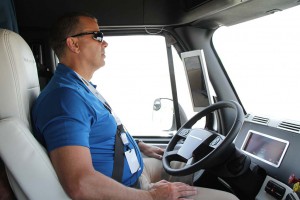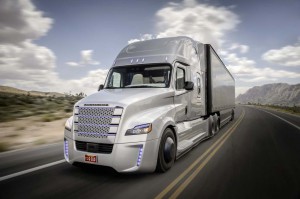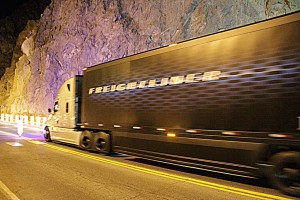Pulling myself up into the cab of the big 18-wheeler, I settle into the shotgun seat and buckle up while driver Mark Alvick fires up the Freightliner semi. With a groan, the airbrakes release, the big diesel rumbles to life and we head off down the highway.
It takes a fair bit of muscle to manage a heavy truck like this, but after a couple moments, Alvick taps a switch on the sprawling instrument console and settles back, both hands off the steering wheel. A brief moment of panic quickly subsides as the truck maintains its rock-steady grip on the road, smoothly negotiating a sweeping curve on the 2-lane blacktop north of Las Vegas.
This isn’t a normal 18-wheeler. It’s the prototype Freightliner Inspiration, the world’s first autonomous heavy truck licensed for use on public roads. The company, the country’s largest manufacturer of heavy trucks, plans several years of tests and, working with its many customers, hopes to commercialize this self-driving technology by decade’s end.
“First time I tried it, I was a bit nervous, especially when I had to pass another truck coming from the other direction” admits Alvick, the Director of Vehicle Performance for Freightliner. “Now I’m very comfortable.”
In fact, Alvick slowly admits, the system does a better job holding its lane than he does, especially after a long day behind the wheel. And that’s one of the reasons why Freightliner and its parent, Daimler Trucks North America, hope to find a market for an autonomous semi.
(Click Here for more on the debut of the world’s first autonomous truck.)
Federal data show that about 90% of heavy truck accidents are the result of human error, quite often due to driver fatigue. Their research indicates truckers are more relaxed when switching to autonomous mode, and less likely to make mistakes.
“If you watch the wheel move, those are all the inputs I’d have to do,” explains Alvick. “It’s fatiguing.”
The system uses a variety of sensors, including a windshield-mounted camera and a radar unit buried in the big grille. It’s a similar setup to what Daimler’s Mercedes-Benz subsidiary is developing for its passenger cars.
(Americans anxious for arrival of autonomous vehicles, finds new JD Power study. Click Here for more.)
But where Mercedes hopes to soon market a fully autonomous vehicles that can do pretty much anything a human driver does, Freightliner is playing things a bit more cautiously.
At least initially, its Inspiration truck – and the production models to follow – will be limited to use on well-paved roads with clearly visible lane markers. A human will still need to sit behind the wheel ready to take over at a moment’s notice in the event of a problem. It won’t be able to execute a pass or pull up to a loading dock. That also will be reserved for the human driver.
But Martin Daum, president of Daimler Truck North America, hints that if the more limited technology proves out – and if both trucking companies and the public accept the idea – future models could be offered with even more advanced features.
There’s also the issue of regulations. Right now, Nevada is the only state in the union that allows testing of autonomous trucks on public roads. Daimler – and other automotive manufacturers – are pressing for uniform federal regulations. In the meantime, Freightliner hopes to log as many miles as possible to prove the technology works.
(Regulators, lawmakers key to roll-out of autonomous technology. Click Here for the story.)
As we approach Interstate 15, Alvick briefly takes control, manually muscling the 70-ton behemoth up the entrance ramp and into traffic before returning to autonomous mode. He takes over once again as we get ready to exit back to our staging center at the Las Vegas Motor Speedway. And, to be honest, as seasoned a driver as he might be, Alvick isn’t quite as smooth as the computer.
But for now, he and the thousands of other truck drivers that move more than three-quarters of America’s freight don’t have to worry about their jobs. They just can look forward to a digital helper that eventually may make the work a little easier and a lot safer.





There is a lot of potential for AVs if done properly. If you view AVs under the criteria of a fail-safe system – that means redundant systems so no matter what sensor fails or what computer gets scrambled or what power surges occur, no matter what hacker tries to take control, the system maintains proper control of the vehicle at all times.
For true autonomous vehicles to exists they must also be able to understand and react appropriately to vehicular accidents, emergency vehicles, extreme weather, etc. It would be unconscionable to sell an AV than isn’t 100% reliable and capable of dealing with all of the above and more such as a sudden lost of power. Anything less is simply unacceptable and should not be allowed on the roadways as an AV.
The truck idea above is clearly a semi-autonomous vehicle with the intent of eliminating driver error from inattentive or fatigued driving. Obviously if we had reasonable truck driving regulations in the U.S. like some other countries have, that would reduce a lot of the fatigue that truck drivers experience.
I still have reservations about a truck driver along for the ride suddenly needing to take control in the event of an accident happening in front of them. milliseconds in response time can be the difference between life and death with a 70,000 rig that is unable to stop or turn on a dime.
Nice piece, Pablo.–Warren